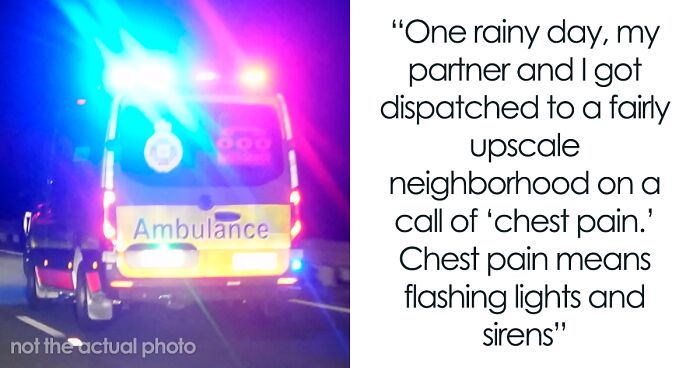
Woman Calls 911, Tells Medics She Wants To Use Their Ambulance As An Uber – They Decide To Teach Her A Lesson
On average, about 240 million Americans call 911 each year. However, a fair portion of these calls do not involve true emergencies and overload the 911 system. Like this one.
Just two days ago, Reddit user JaeCryme shared a story on r/MaliciousCompliance about the time when they were a paramedic in Salt Lake City, Utah, and rushed to help a woman with “chest pain.”
When they got to her place, the woman revealed she didn’t need immediate medical attention—she made the 911 call just to get a free ride.
Luckily, her plan didn’t work out.
Image credits: Tomás Del Coro (not the actual photo)
Image credits: JaeCryme
JaeCryme had worked in EMS for 5 years in varying roles at varying levels of certification. “I made $9 per hour while working in Salt Lake City as an AEMT, and literally broke my back lifting a heavy patient, so I had to quit,” they told Bored Panda. “There’s no typical day in EMS. One day, I was dispatched after 3 minutes on shift… although that ended up being one of the funniest calls of my life, so no regrets.”
Other days, they’d just sit around, cleaning the station, inventorying supplies, etc., “doing nothing and just waiting, only to get our first call just a few minutes before the shift was over.”
There were also shifts when they’d be there longer. “I once ran 38 hours straight,” JaeCryme recalled.
But during that time, the Redditor hadn’t been in many situations like this one. “I personally only had like 3 actual EMS abuse calls in those 5 years—really fake calls like the one I shared—but everyone has these stories.”
Since JaeCryme never followed up on their patients after they dropped them off, they don’t really know what happened to this particular lady after she left the vehicle. “Some medics obsessively want to know their patient outcomes [but] I had a policy of ‘I got them there alive, that’s all that matters to me,'” JaeCryme explained.
In 2016, there was a study that investigated how paramedics view and judge appropriate versus inappropriate ambulance use. The researchers conducted interviews with 19 paramedics working in two regions in southwestern Ontario, Canada, and analyzed them using grounded theory methods.
“While blatantly ‘inappropriate’ use is extraordinary, ‘misuse’ is more common, and paramedics determine misuse largely by interpreting patients’ abilities to cope with their situations,” the study found. “Paramedics assess this using multiple patient attributes: patient’s age, knowledge of the system, system failures, social support available, presence of transportation alternatives, patient’s ability to walk and trial of treatment with home remedies.”
The researchers also noted that ‘inappropriate’ ambulance use has serious repercussions. When non-urgent patients are triaged to lower emergency department (ED) priority, they may have to wait many hours for care. In some cases, the paramedics may need to wait with them, delaying response to other emergency calls, and depriving the paramedics of opportunities for meals, sleep and education. The inappropriate use of EMS drains health system resources and undermines paramedic morale. Furthermore, for non-urgent patients, ED care may be less effective than primary care, and can ultimately delay their appropriate care.
“I’d just add that everyone in EMS shares their funny and frustrating stories as a form of therapy,” JaeCryme said. “The EMS profession has a high rate of suicide and burnout, so it’s cathartic to vent. Even years after leaving service.”
“And I’d also add that the absolute vast majority of calls are legitimate emergencies, or what patients at least perceive as emergencies. With all of the calls for a national healthcare system in the US, I’d rather see ambulances be free for people who need them, and only the wrongdoers be punished.”
Here’s what people said after reading the story
She probably received a hefty bill. I work in medical insurance, there is a code for "paramedics determined this was not an emergency, but patient insisted upon being transported via ambulance." It is automatically denied by insurance as medically unnecessary.
Load More Replies...In developed countries they are free (for medical emergencies)
Load More Replies...I'm sorry they didn't call a Life Flight (helicopter ambulance) for her. Those things are rarely covered by insurance and cost around 40K.
Another made up reddit story, if you ask me. Why would a woman from an upscale neighbourhood bother to do this instead of getting in her surely expensive car and driving to the hospital herself?
I really think all of these stories are made up! I don't know why i still read them
Load More Replies...This makes me so sad. My husband had the widow makers heart attack at home with 100% blockage. Somehow he survived, which is unheard of. He was in his 40's and home alone doing yard work. He called me and I called EMS who helped save his life! A few years later I was extremely sick, I was in my 30's. I had been to the ER and the doctor a few days prior. My husband found me in bed with arms and legs blue and finger and toe nails black from lack of oxygen. The same EMS came and rushed me to the ER, where I spent the next two weeks in the ICU on a breathing machine due to pneumonia is all 5 lobes of my lungs. Both my husband and I should of died, but due to the quick response of EMS we were saved! It breaks my heart to think of all the people who could not be saved due to people abusing the system.
How can she afford that?! At least a couple hundred for an ambulance ride! Just call an Uber or taxi!
Not that this is an excuse AT ALL - but maybe, just maybe, she misunderstood the good advice that is: when you have a real emergency, you WILL get admitted into the ER faster if you arrive via ambulance than if you drive yourself and walk in. She's an ass-hat for sure, though.
By sixty seconds, maybe. The advantage of coming in lights and sirens is that we will call in a report from the back of the truck, so that the ER will be aware that there is a, say, 62 year old male with a compound fracture of the left tibia, alert and oriented, with blood pressure at this and heart rate at that, inbound five minutes away. So they'll be ready to meet you at the door. If you don't do that, the triage nurse will have to do that themselves, which could take thirty seconds, and then another thirty seconds to get you moving. They're really good in the ED. Going in with paramedics is beneficial because your care starts at the beginning of transport rather than at the end, but you won't be seen any earlier either way. They will triage you the same as anybody else, and find a place to put you, and treat you in order of severity.
Load More Replies...I want whatever insurance this lady has! I initialy assumed this was a non US story, but it says Salt Lake Utah. I don't know anyone whose insurance deductible for an ambulance ride is less than the cost of a Taxi.
In Australia, ambulance rides costs more than $1,200. But, it's free, if you have health insurance or a health concession card (taxpayers pay for it). If people can't afford health insurance, but don't qualify for a health concession, they can purchase an ambulance subscription from their State Ambulance service. A single annual subscription for Victoria is $48.35 and a family subscription is $96.70. Well worth it.
Every bogus 911 call means someone who needs EMS/cops is losing time that could save their life. The other one is "Oh I feel bad but don't take me ot the hospital." Sorry, but EMS is not a house-call service. You want a medical exam at home, get a concierge doctor. You feel bad but not ER bad? Go to a doctor's office if you can, and a walk-in urgent-care if you can't. My one firend's mom is now blacklisted by 911 for such behavior ("I think I feel sick but I don't want to go to hospital" about 15 times in 4 weeks), and now if she's in real trouble, the EMS will not take it seriously. Do not "cry wolf"!
I would rather take an Uber to the ER than an ambulance anywhere. Not paying hundreds of dollars for a ride in the Wee-Woo wagon.
There are ambulances that do you take back and forth from an medical appointment. I think they are paid by insurance. Maybe she didn't know. How did she get home?
There are; I work for one. Every trip, I fill out paperwork explaining why it was necessary to go by ambulance instead of Uber or a chair car. I get an RN to write down why it is that they had to be transported lying down, or continuously monitored, or whatever the reason is. Every trip. If I take someone to dialysis three times a week, I fill out six sheets that way. Some of the nurses have a post-it-note to remind them exactly what to write. If I don't get it VERY specific, insurance fights back. I will get a note back from pre-bill saying, "Okay, you said that he had to be transported by ambulance because he's bed-bound because his legs aren't weight-bearing because he is paralyzed, but you forgot to write WHY he is paralyzed, please write that he had a CVA so we can re-submit it." If they can sit up and care for themselves, insurance will only pay for a wheelchair car. If they can stand and move for an extended period of time, the best they'll get is a taxi voucher.
Load More Replies...It's because dipshits like this lady exists, there are copious amounts of regulations and paperwork in the bureaucracy. Just so no one is dipping their hands into the proverbial jars.
Maybe if we had adequate services for seniors, they wouldn't feel the need to abuse emergency services so often.
She probably received a hefty bill. I work in medical insurance, there is a code for "paramedics determined this was not an emergency, but patient insisted upon being transported via ambulance." It is automatically denied by insurance as medically unnecessary.
Load More Replies...In developed countries they are free (for medical emergencies)
Load More Replies...I'm sorry they didn't call a Life Flight (helicopter ambulance) for her. Those things are rarely covered by insurance and cost around 40K.
Another made up reddit story, if you ask me. Why would a woman from an upscale neighbourhood bother to do this instead of getting in her surely expensive car and driving to the hospital herself?
I really think all of these stories are made up! I don't know why i still read them
Load More Replies...This makes me so sad. My husband had the widow makers heart attack at home with 100% blockage. Somehow he survived, which is unheard of. He was in his 40's and home alone doing yard work. He called me and I called EMS who helped save his life! A few years later I was extremely sick, I was in my 30's. I had been to the ER and the doctor a few days prior. My husband found me in bed with arms and legs blue and finger and toe nails black from lack of oxygen. The same EMS came and rushed me to the ER, where I spent the next two weeks in the ICU on a breathing machine due to pneumonia is all 5 lobes of my lungs. Both my husband and I should of died, but due to the quick response of EMS we were saved! It breaks my heart to think of all the people who could not be saved due to people abusing the system.
How can she afford that?! At least a couple hundred for an ambulance ride! Just call an Uber or taxi!
Not that this is an excuse AT ALL - but maybe, just maybe, she misunderstood the good advice that is: when you have a real emergency, you WILL get admitted into the ER faster if you arrive via ambulance than if you drive yourself and walk in. She's an ass-hat for sure, though.
By sixty seconds, maybe. The advantage of coming in lights and sirens is that we will call in a report from the back of the truck, so that the ER will be aware that there is a, say, 62 year old male with a compound fracture of the left tibia, alert and oriented, with blood pressure at this and heart rate at that, inbound five minutes away. So they'll be ready to meet you at the door. If you don't do that, the triage nurse will have to do that themselves, which could take thirty seconds, and then another thirty seconds to get you moving. They're really good in the ED. Going in with paramedics is beneficial because your care starts at the beginning of transport rather than at the end, but you won't be seen any earlier either way. They will triage you the same as anybody else, and find a place to put you, and treat you in order of severity.
Load More Replies...I want whatever insurance this lady has! I initialy assumed this was a non US story, but it says Salt Lake Utah. I don't know anyone whose insurance deductible for an ambulance ride is less than the cost of a Taxi.
In Australia, ambulance rides costs more than $1,200. But, it's free, if you have health insurance or a health concession card (taxpayers pay for it). If people can't afford health insurance, but don't qualify for a health concession, they can purchase an ambulance subscription from their State Ambulance service. A single annual subscription for Victoria is $48.35 and a family subscription is $96.70. Well worth it.
Every bogus 911 call means someone who needs EMS/cops is losing time that could save their life. The other one is "Oh I feel bad but don't take me ot the hospital." Sorry, but EMS is not a house-call service. You want a medical exam at home, get a concierge doctor. You feel bad but not ER bad? Go to a doctor's office if you can, and a walk-in urgent-care if you can't. My one firend's mom is now blacklisted by 911 for such behavior ("I think I feel sick but I don't want to go to hospital" about 15 times in 4 weeks), and now if she's in real trouble, the EMS will not take it seriously. Do not "cry wolf"!
I would rather take an Uber to the ER than an ambulance anywhere. Not paying hundreds of dollars for a ride in the Wee-Woo wagon.
There are ambulances that do you take back and forth from an medical appointment. I think they are paid by insurance. Maybe she didn't know. How did she get home?
There are; I work for one. Every trip, I fill out paperwork explaining why it was necessary to go by ambulance instead of Uber or a chair car. I get an RN to write down why it is that they had to be transported lying down, or continuously monitored, or whatever the reason is. Every trip. If I take someone to dialysis three times a week, I fill out six sheets that way. Some of the nurses have a post-it-note to remind them exactly what to write. If I don't get it VERY specific, insurance fights back. I will get a note back from pre-bill saying, "Okay, you said that he had to be transported by ambulance because he's bed-bound because his legs aren't weight-bearing because he is paralyzed, but you forgot to write WHY he is paralyzed, please write that he had a CVA so we can re-submit it." If they can sit up and care for themselves, insurance will only pay for a wheelchair car. If they can stand and move for an extended period of time, the best they'll get is a taxi voucher.
Load More Replies...It's because dipshits like this lady exists, there are copious amounts of regulations and paperwork in the bureaucracy. Just so no one is dipping their hands into the proverbial jars.
Maybe if we had adequate services for seniors, they wouldn't feel the need to abuse emergency services so often.
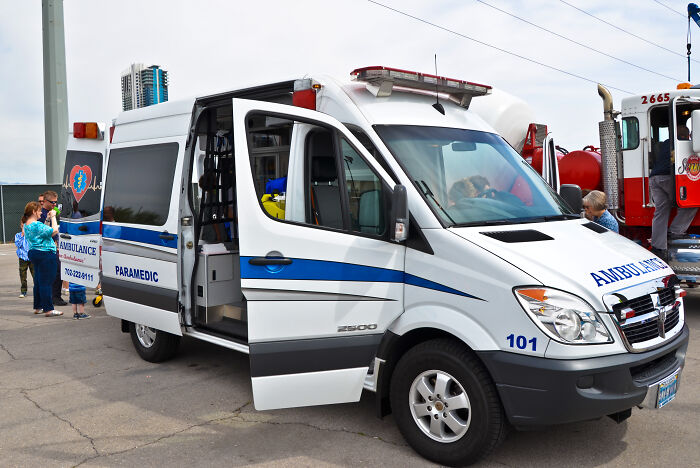
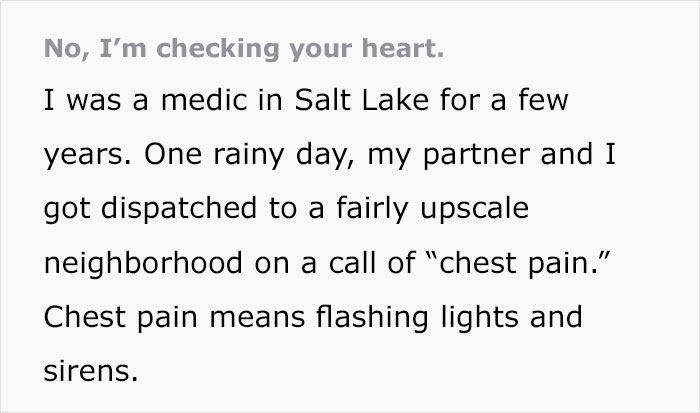
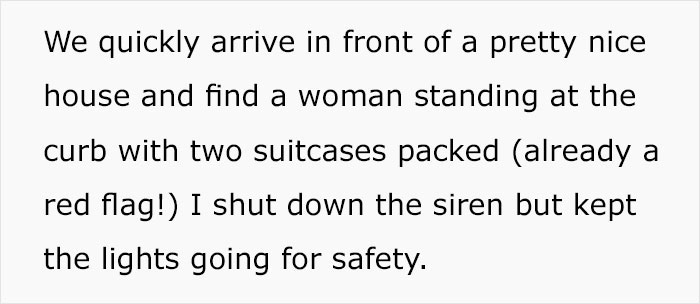
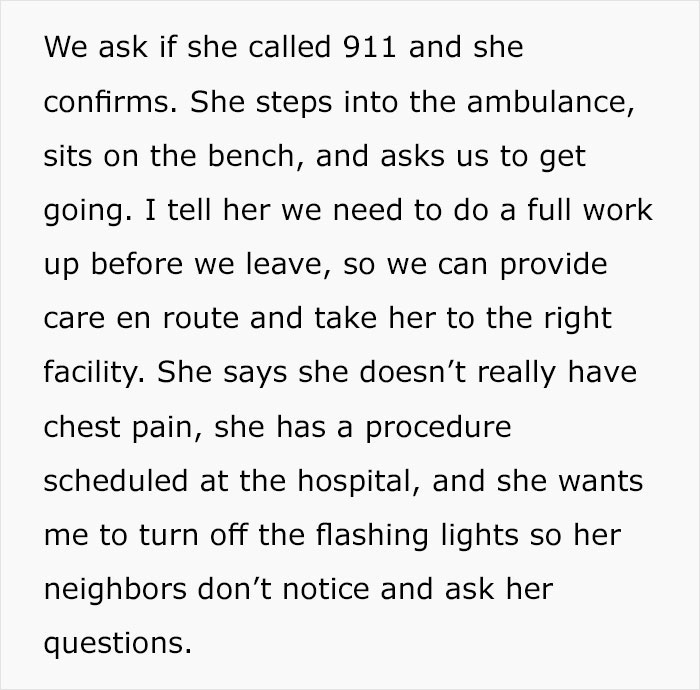
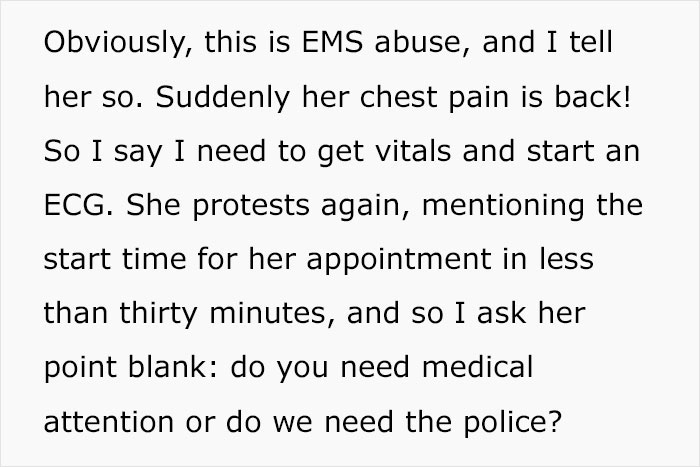
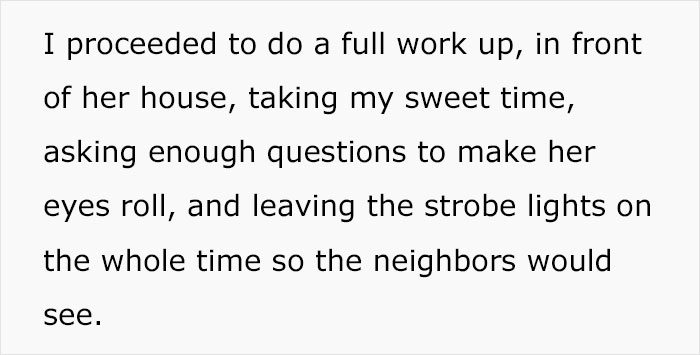

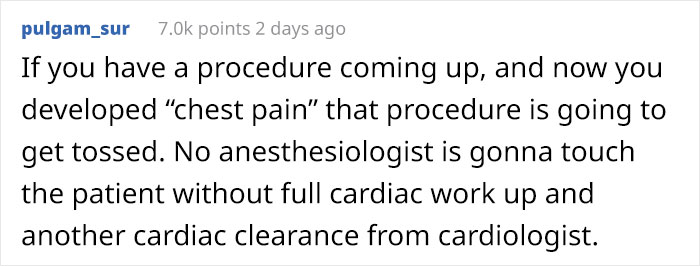



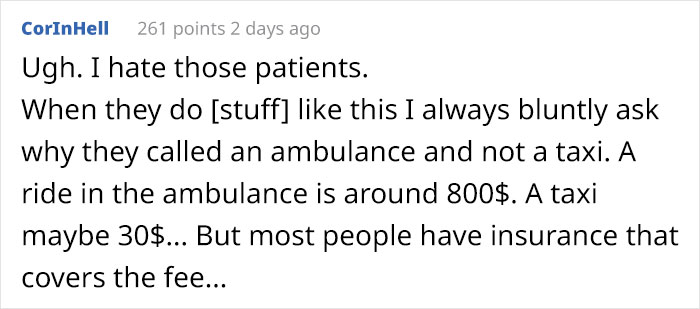

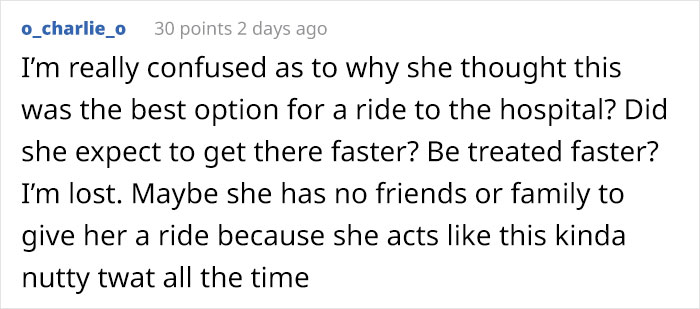

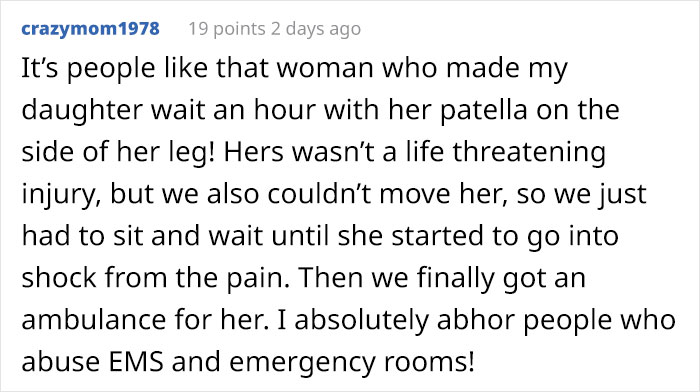
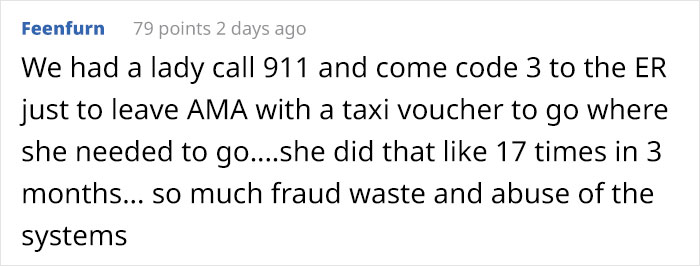




130
63